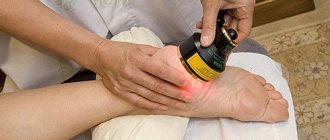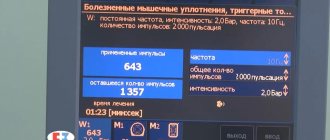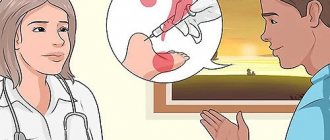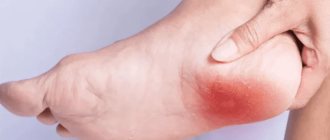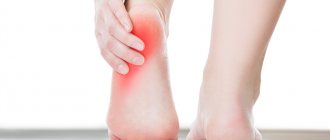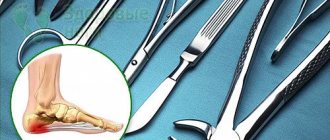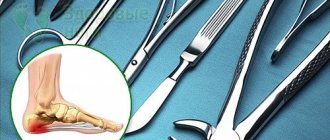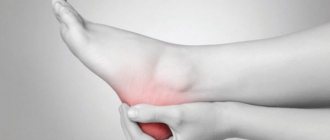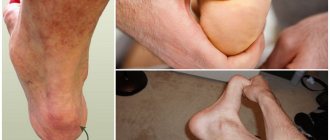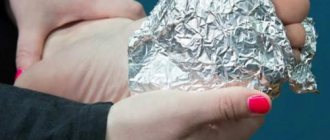Heel spurs (fasciitis) cause many problems for their owner. A person experiences constant pain, cannot fully move and live a full life.
Modern medicine approaches the treatment of fasciitis in a comprehensive manner, combining drug therapy with physiotherapy and heel unloading using insoles and heel supports.
Physiotherapy for heel spurs based on shock wave exposure (SWT) gives excellent results. This technique is used at any stage of the disease, helping the patient quickly get rid of pain and reduce bone-salt buildup.
Shock wave therapy for heel spurs: high efficiency and quick results
Many people suffer from heel spurs.
This disease, called plantar fasciitis by doctors, causes severe pain, makes it difficult to move and reduces quality of life. Why does a spur appear on the heel? How to get rid of it? How does shock wave therapy differ from other treatment methods? What advantages does it have? Are there any disadvantages and contraindications?
To completely defeat the disease, it is necessary to consult a doctor at the slightest manifestation of pain, who will select the optimal treatment method.
Although there are many methods used to combat the disease, most of them provide only temporary relief from pain. Therefore, shock wave therapy is becoming increasingly popular. It is the most effective method of treating heel spurs and a worthy alternative to surgery. During an SWT session, ultrasonic waves of different frequencies are directed to the heel. Under their influence, the destruction of ossified areas occurs - salt deposits are softened and removed from the body.
CUSTOM ORTHOPEDIC INSOLES FORMTOTIX
Properly selected insoles allow you to correct the position of the foot when you walk, eliminating discomfort and flat feet. Insoles eliminate the biomechanical cause of heel spur disease. FORMTOTIX custom orthopedic insoles are manufactured in New Zealand and are rightfully recognized as one of the best insoles by doctors around the world. The selection of insoles is carried out exclusively by doctors who have been trained and have a certificate.
UVT: advantages and disadvantages
Shock wave therapy for heel spurs has several benefits:
- improves blood circulation, which helps prevent relapses;
- triggers the mechanism of decomposition of salt accumulations;
- strengthens tendons and ligaments;
- provides quick results;
- has no side effects;
- has almost no contraindications;
- does not require surgical intervention and long-term rehabilitation;
- sessions can be carried out in an outpatient setting.
After shock wave therapy, in 80% of cases, pain disappears after the first session, and complete recovery occurs after completion of the course of therapy.
The main disadvantage is the high cost of the therapeutic course. In addition, for people with hypersensitivity, the first sessions of therapy cause severe pain. If the patient does not follow the doctor’s recommendations, then a relapse is possible after some time.
Infrasound and its capabilities
Shock wave therapy (SWT) works on the basis of infrasound, the frequency of which does not exceed sixteen Hertz. SWT is used in medical fields related to the treatment of the musculoskeletal system; it is used in physiotherapeutic procedures, rehabilitation of athletes after injuries, restoration of reproductive function in men, as well as in the treatment of disorders and injuries in animals. This technique allows you to fight pain and restore joint mobility.
During the UVT procedure, the skin and mucous membranes are not damaged, so it does not require anesthesia. The main operating aspect of UVT is infrasound, which easily penetrates the skin, tendons, ligaments, muscle tissue and biological fluids: if there is tension somewhere, infrasound relaxes the structure and relieves it of pain. The infrasonic wave slows down its movement in cartilage and bones, while it generates additional energy that removes unhealthy and unnatural growths in the body - for example, violations of the structure of bone tissue in the spine.
UVT capabilities:
- forms the growth of young blood vessels: they deliver a sufficient amount of oxygen to the tissues, blood circulation is restored - thanks to this, bones and tendons come into working condition;
- helps reduce the concentration of the so-called “pain substance”, which causes pain in the arms, legs, shoulder joints, neck and back;
- destroys calcified cells of auxiliary tissues and, thus, ensures the prevention of damage and mini-ruptures of tendons; stimulates the body to produce its own collagen in order to promptly heal damaged ligaments, muscles and bones.
Preparing for treatment sessions
Before conducting a course of shock wave therapy for a heel spur, the attending physician will refer the patient for a consultation with an orthopedist. It is imperative to undergo diagnostics:
- x-ray in two projections - the images will show the exact location of the growth and its size;
- Ultrasound examination will determine the stage of the disease.
If it is necessary to clarify the diagnostic results or differentiate a heel spur from arthrosis or arthritis, then resort to magnetic resonance imaging.
It is also necessary to take a blood test for clotting. Without seeing a coagulogram, the doctor will not prescribe UVT.
After receiving the diagnostic results, you will need a second consultation with an orthopedist. Using palpation, he will find the point that should be affected by ultrasound.
Causes
Usually this is not a single factor, but a whole complex of reasons. People who are overweight often suffer from heel spurs - in this case, an excessively high load falls on the feet, and the bones can even shift. Another risk group includes people whose professional activities or hobbies involve too much stress on their legs: runners, hikers. If the patient has already been diagnosed with diseases of the joints of the lower extremities (for example, rheumatoid arthritis, osteoarthritis, etc.), the likelihood of developing fasciitis also increases. Pregnancy, flat feet, foot injuries and metabolic disorders can also be triggers for the problem.
How does therapy work?
The patient sits comfortably (sitting or lying down) and relaxes. The skin on the damaged area is treated with gel to improve contact between the skin and the sensor head. Then a sensor is applied to the heel, which sends ultrasonic pulses to a depth of 3-4 centimeters. The waves easily pass through soft tissue and, reflected from the bone, return back. Such micromassage destroys calcifications and promotes their removal along with the blood flow.
The duration of the UVT session is 10-30 minutes. The course of treatment includes 4-7 procedures, between which there are breaks of 3-7 days (for tissue restoration), and sometimes 20, which depends on the patient’s individual response to therapy. If pain intensifies during the procedure, then the intervals between sessions are lengthened.
When drawing up a treatment course, the doctor takes into account the tolerability of the procedure and the dynamics of changes. If necessary, he makes adjustments during the treatment process.
Only some people feel severe pain during sessions. Others may only feel a slight tingling or tingling sensation. After the session, aching pain may disturb the patient for several hours. But after completing the full course of shockwave therapy, the pain will no longer return.
Why should you choose a clinic with German BTL equipment?
At East Clinic, when treating with successful wave therapy techniques, specialized BTL devices are used. They are distinguished by the famous German reliability and, in addition, by the preferences of the patients themselves.
Why we value BTL equipment:
- helps restore joint mobility without anesthesia and the use of medications;
- its power significantly exceeds that of other similar UVT systems;
- you need to spend only 10 minutes and carry out a course of three to four procedures to get rid of pain in muscles and bones;
- helps to quickly recover from operations, sports injuries, orthopedic problems;
- The device can be used to carry out treatment not only using the UVT method alone, but also combining it with other methods of physiotherapy. For example, to relax muscles, relieve spasms and pain, you should combine shockwave therapy with electrotherapy; to relieve swelling and accelerate the healing of bones and soft tissues, a combination with magnetotherapy is necessary; to achieve an anti-inflammatory effect, as well as to restore and biostimulate tissue, UVT should be used in conjunction with a laser; to reduce swelling and relax muscles - with ultrasound.
Contraindications
You will have to refuse treatment of heel spurs with shock wave therapy if:
- violation of blood clotting properties;
- heart problems associated with rhythm disturbances;
- low blood pressure (hypotension, vegetative-vascular dystonia);
- weakness of the vascular wall;
- damage to the skin;
- acute inflammatory processes in the area of nerve trunks;
- vascular diseases (thrombosis, thrombophlebitis, phlebitis, varicose veins);
- acute infectious diseases (if you ignore this point, the risk of complications increases significantly);
- intoxication of the body;
- the presence of malignant tumors in the area of influence or in the hematopoietic organs;
- pregnancy (pathologies may occur during fetal development);
- breastfeeding (possibly decreased lactation).
In case of disorders in the functioning of the nervous system, the doctor prescribes therapy with caution, taking into account the individual characteristics of the patient.
You should also be careful when treating children if their bone tissue growth areas have not closed. In this case, shock wave therapy can disrupt the bone structure, which will adversely affect the structure of the skeleton.
Main symptoms
Fasciitis usually manifests as pain in the heel:
- when walking;
- while playing sports;
- when trying to resume movement after a long pause;
- when touching the problem area.
The intensity of pain can be different - it depends on the stage of the disease and on the individual anatomical characteristics of a particular person. After a period of rest, the pain usually stops, but as soon as you resume exertion, the discomfort returns. Some patients describe the sensation as “like a nail piercing the heel.” There is swelling of the foot, pain can spread to the foot and ankle, and the tissue around the spur becomes inflamed.
It is quite logical that the gait of people with fasciitis changes - when walking, a person tries not to step on the sore area, and begins to walk on his toes. Over time, complications may develop - most often pathologies of other joints of the legs (knees, hips).
Side effects
Side effects after treatment of heel spurs with shock wave therapy are extremely rare, but they are still possible. In 20-25% of patients, the pain syndrome intensifies at the beginning of treatment. To eliminate it, the doctor prescribes analgesics and anti-inflammatory drugs. Sometimes (with increased sensitivity of the body) severe pain develops during the procedure. In such cases, the therapeutic effect is performed under local anesthesia.
If contraindications are not followed, hematomas may appear in the affected area or other undesirable complications may occur.
In most cases, shock wave therapy is used in combination with other methods (medication, physical therapy, massage, other physical therapy procedures), which significantly increases the effectiveness of treatment.
Advantages of the ESWT method
Treatment with extracorporeal focused shock wave therapy (EFSWT) allows manipulation to be performed on an outpatient basis, while the duration of the procedure does not exceed 25 - 50 minutes (depending on the area and extent of the lesion). Patients note a significant reduction in pain immediately after the end of the first session, and then the pain gradually decreases over some time (from 5 hours to 3 days). Complete relief of pain occurs within a week or two after completion of the course of treatment. Depending on the severity and characteristics of the pathology, the doctor may prescribe the required number of sessions, which are carried out several times a week. Additionally, conservative therapy methods and physiotherapeutic treatment can be used.
This treatment method and the equipment used, the DUOLITH SD1 T-TOP “F-SW ULTRA” , allows you to get rid of the disease with maximum efficiency. Under the influence of a focused shock wave, calcium deposits are loosened and subsequently washed out of the body with the bloodstream, the ligament gets rid of accumulated calcifications, the active process of tissue regeneration is also activated, fibrous tissue is absorbed, swelling decreases and the inflammatory process stops. The affected area restores its structure and ability to bear the necessary loads without creating pain. In the initial stages of the disease, the disease is completely eliminated, and in cases with a long duration of the process, inflammation is suppressed and the deposition of calcium compounds in the ligament is stopped. The pain syndrome becomes less with each procedure performed and, as a rule, completely disappears by the end of treatment.
Data from objective studies indicate the achievement of a lasting treatment effect in the majority of patients, and this result is confirmed by both domestic and foreign experts. Numerous advantages and high efficiency of the ESWT method allow us to consider it not only effective, but also the most promising, because it makes it possible to avoid surgery and leads to recovery.
Contraindications for UVT are:
- blood clotting disorder (hemophilia);
- use of anticoagulants, especially marcumar;
- thrombosis;
- tumors, carcinomas (tumors lying next to the treatment area);
- cortisone therapy for up to 6 weeks before the first therapeutic procedure;
- presence of infection in the affected area;
- presence of a pacemaker;
- acute infectious diseases.
For what diseases is UVT contraindicated?
- acute infections
- bleeding disorders
- oncology
- epilepsy
- mental illness
- presence of a pacemaker
- thrombophlebitis of the deep veins of the lower extremities
- chronic renal and liver failure
- diseases of the endocrine system.
In addition, SWT is not used in patients:
- under 18 years of age
- during pregnancy and breastfeeding
- while taking hormone therapy
- in the area of the skull and large (main) vessels
- after sclerotherapy on the veins.
